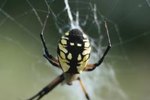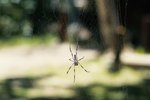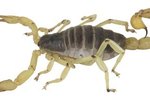The United States has received so much from its mother country, Great Britain. In addition to a common language and literature, many domestic animals came to America via its British forebears. The ships bringing settlers and livestock brought some undocumented creatures as well, including the woodlouse spider (Dysdera crocata). This British invader now resides throughout much of the U.S., especially in climates somewhat reminiscent of its ancestral home.
Woodlouse Spider Appearance
Also known as the woodlouse hunter or sow bug killer, the woodlouse spider has very large, thick mouth parts, with which it can capture and kill its relatively big prey. The cephalothorax, consisting of the thorax and head, is dark reddish-brown, while the abdomen is lighter-colored. The spider's six eyes form an oval on the head. At maturity, the female woodlouse spider is about 1/4-inch long, with males slightly smaller.
Woodlouse Spider Range
In North America, the woodlouse spider is found primarily along the eastern seaboard, ranging from New England in the north to Georgia in the south. Generally, it lives east of the Mississippi River. While rarely found in the deep South, Midwest or Southwest, it thrives on the West Coast, dwelling in California, Oregon, Washington and British Columbia. It's also found along the Californian and Mexican border.
Woodlouse Spider Habits
Unlike other spiders, the woodlouse doesn't spins webs to ensnare victims. Instead, it hunts its prey, which consist primarily of wood lice. In the U.S., wood lice are commonly referred to as sow bugs, pill bugs or roly-polys. These aren't actually lice, but a type of crustacean. The woodlouse spider also eats other insects and smaller spiders. A nocturnal hunter, the spider rests during the day under rocks or logs. In cold weather, the spider might retreat to the warmth of buildings.
Spider Bites
Woodlouse spiders will bite if provoked, but their bites are fairly innocuous. Because this arachnid bears a resemblance to the brown recluse spider, whose bite can prove fatal, it's better to be safe than sorry and have any bite checked by a medical professional. For most victims, a woodlouse spider bite entails no more than a brief period of minor discomfort. The bite might swell up and cause itching.
References
Writer Bio
Jane Meggitt has been a writer for more than 20 years. In addition to reporting for a major newspaper chain, she has been published in "Horse News," "Suburban Classic," "Hoof Beats," "Equine Journal" and other publications. She has a Bachelor of Arts in English from New York University and an Associate of Arts from the American Academy of Dramatics Arts, New York City.





